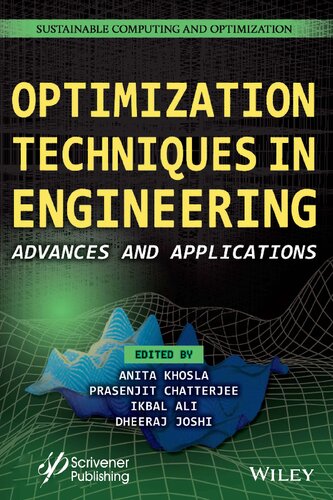Product desciption
Optimization Techniques In Engineering Advances And Applications Anita Khosla by Anita Khosla, Prasenjit Chatterjee, Ikbal Ali 9781119906278, 111990627X instant download after payment.
The book describes the basic components of an optimization problem along with the formulation of design problems as mathematical programming problems using an objective function that expresses the main aim of the model, and how it is to be either minimized or maximized; subsequently, the concept of optimization and its relevance towards an optimal solution in engineering applications, is explained.
This book aims to present some of the recent developments in the area of optimization theory, methods, and applications in engineering. It focuses on the metaphor of the inspired system and how to configure and apply the various algorithms. The book comprises 30 chapters and is organized into two parts: Part I ― Soft Computing and Evolutionary-Based Optimization; and Part II ― Decision Science and Simulation-Based Optimization, which contains application-based chapters.
Optimization techniques are meant to solve optimization of smooth problems where it follows to find gradient of the functions. Gradients look into minima value unfortunately local minima can be a hindrance. Genetic algorithm (GA) follows biological evaluation that provides fittest solution to smooth problems and many times even to discontinue functions. GA integrated with neural network enhances its learning capabilities and input selection. This integration can be a fathom to a variety of speech processing applications, like automatic speech recognition (ASR), speech emotion recognition (SER), hate speech detection, and many other. GA plays a good role in selecting the fittest parameter set in voice activity detection, feature selection, phonetic decoding of ASR.
Particle swarm optimization (PSO) has gained its importance over last 20 years and has been proven successful in many domains and disciplines of science and technology, as well as in other fields. It has shown its ability in optimizing various complex problems in a simpler way. Due to its simplicity and worldwide applications, the latest breakthroughs in PSO, as well as their applications in various fields are stated in this chapter. Its significance, algorithm and working mechanism along with the pseudo-code are presented in this chapter. The utility of PSO has been addressed and the flaws in the algorithm have been recognized. The recent advancements and modifications of PSO in terms of its parameters are also discussed. Finally, its hybridization with other illustrious algorithms and applications in multiple disciplines and domains over the last decades are discussed.
Readers and users will find in the book:
An overview and brief background of optimization methods which are used very popularly in almost all applications of science, engineering, technology, and mathematics;
An in-depth treatment of contributions to optimal learning and optimizing engineering systems;
Maps out the relations between optimization and other mathematical topics and disciplines;
A problem-solving approach and a large number of illustrative examples, leading to a step-by-step formulation and solving of optimization problems.
Audience:
Researchers, industry professionals, academicians, and doctoral scholars in major domains of engineering, production, thermal, electrical, industrial, materials, design, computer engineering, and natural sciences. The book is also suitable for researchers and postgraduate students in mathematics, applied mathematics, and industrial mathematics.


